Historic Houses and Homesteads in Old Norwood Park

West elevation, John Wingert House at 6231 North Canfield Avenue. [Gabriel X. Michael/Chicago Patterns]
It’s one of the farthest neighborhoods from downtown Chicago, bordering the city limits, O’Hare Airport and suburbs of Harwood Heights and Norridge. But Norwood Park can also be considered one of the city’s oldest areas, where you will find remarkable 150-year-old examples of early American homes in every Victorian-era style.
From Outlying Farmland To Chicago Neighborhood
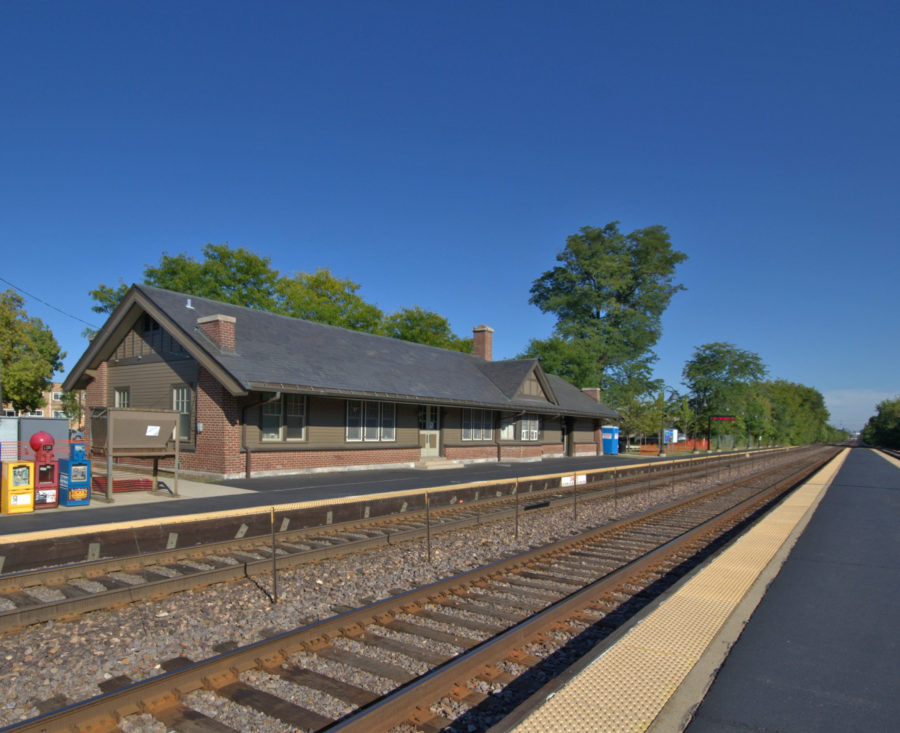
Norwood Park Metra station [Gabriel X. Michael/Chicago Patterns]
The land making up Norwood Park was originally settled by English farmers in the 1830s, and later populated by Germans and Scandinavians. Norwood Park was officially incorporated in 1874, organized from parts of nearby Jefferson, Leyden, and Niles Townships, and in 1893 it was annexed by the City of Chicago.
In 1853, the railroad came to Norwood Park near the site of its current station pictured above—the Illinois and Wisconsin Railroad began service here, eventually becoming the Chicago and Northwestern Railway. The Norwood Park train station, served by the Metra Union Pacific Northwest railroad, is located at 6088 North Northwest Highway. Built in 1907, it was designed by architects Frost & Granger, and added to the National Register of Historic Places in 2001. It is Orange-Rated in the Chicago Landmarks Historic Resources Survey (CHRS).
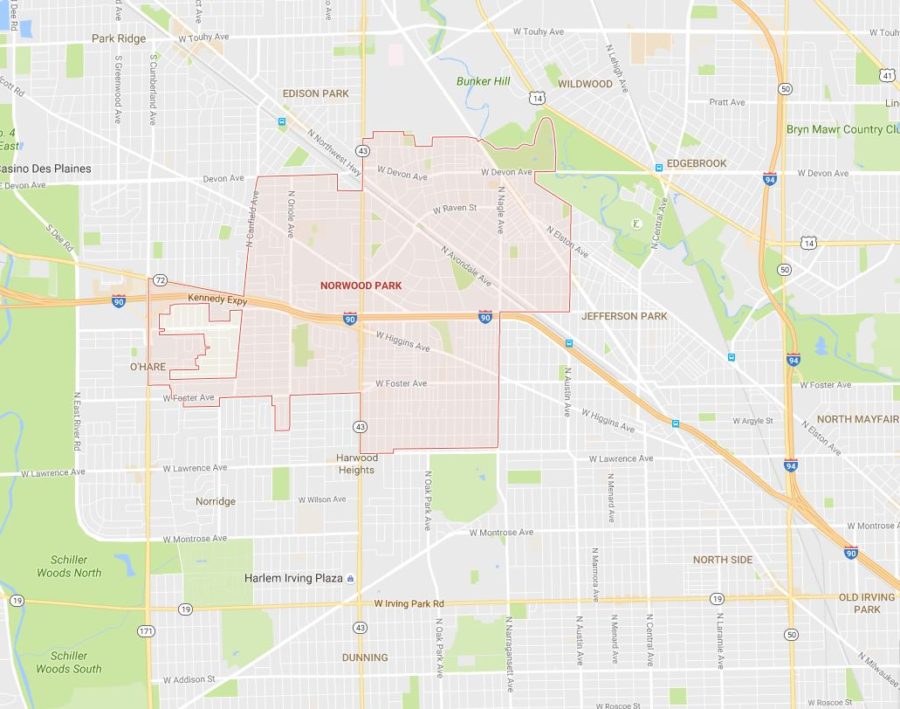
Map of the Norwood Park area outlined in red. Old Norwood Park is located near the center, north of Interstate 90 and east of Harlem Avenue. [Google Maps]
Norwood Park has a complicated but interesting geography. The Metra Union Pacific-North commuter railroad runs on the former Chicago and North Western rails, making stops here and at Jefferson Park and Edison Park to the southwest and northwest, respectively. Five diagonal streets run through the area (Higgins Avenue, Talcott Avenue, Avondale Avenue, Northwest Highway, and Milwaukee Avenue), breaking up the perpendicular grid, and the neighborhood looks like it’s cut in half horizontally by Interstate 90, which runs along Bryn Mawr Avenue at 5600 North. During its construction in the 1950s, the Kennedy Expressway was specifically routed around the heart of Old Norwood Park and its historic Victorian houses.
Aside from the handful of diagonals cutting through the streetscape, early developers took an imaginative cue from Frederick Law Olmsted’s Picturesque design of the suburb of Riverside to the southwest. From 1868-1869, in the area east of Harlem Avenue (7200 West) they platted winding roads and curvilinear streets to engage with the area’s woodlands and hills, pocketed with expansive public green spaces, to create a unique and innovative streetscape unlike any other Chicago neighborhood. Further developments like a hotel and an artificial lake intended to attract Chicagoans to Norwood Park as a kind of resort or vacation getaway from the industrialized and crowded inner city, but these had little success.
Central to the overall Picturesque design was Circle Avenue, an oval-shaped road in the center of Old Norwood Park that is the address for a fantastic concentration of beautiful 19th-Century homes dating to the 1860s and older. Circle Avenue is divided into east and west portions (North East Circle Avenue and North West Circle Avenue), and public parks occupy irregular lots formed at intersecting streets.
These include the centrally-located Norwood Circle Park, Norwood Park (similar names, different parks) and smaller lots like Mulberry Point Park and Myrtle Grove Park are found nearby. Two Chicago Public School buildings sit within Old Norwood Park also: Norwood Park Elementary in the northern quadrant of Circle Avenue, and Taft High School that occupies the neighborhood’s southeastern corner at Bryn Mawr Avenue and Northwest Highway.
Two of the Oldest Houses in Chicago
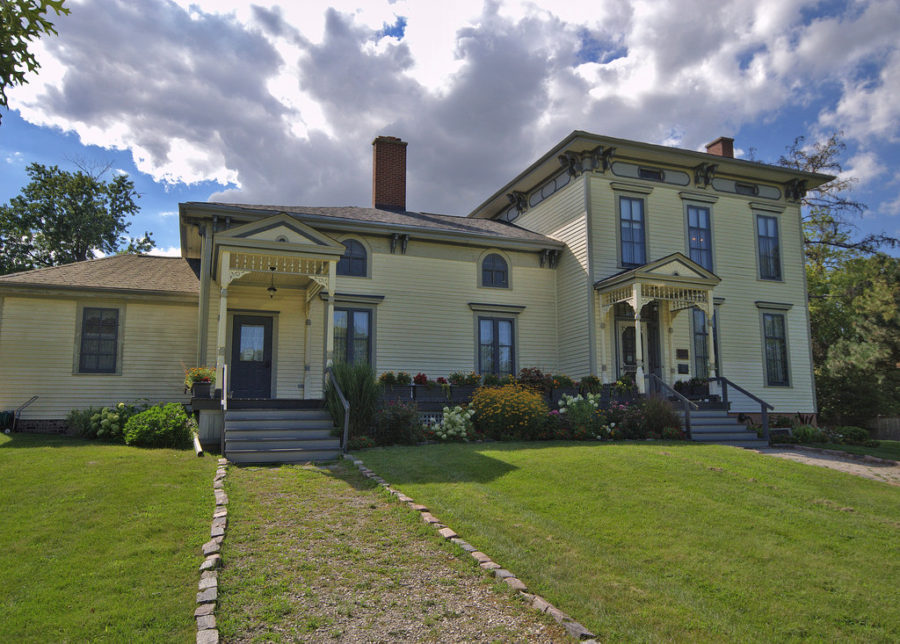
Noble-Seymour-Crippen House, 5624 North Newark Avenue, built 1833. [Gabriel X. Michael/Chicago Patterns]
One of the best known features of Old Norwood Park is that it contains Chicago’s oldest existing house. Four years older than the Clarke House, it is the Noble-Seymour-Crippen House at 5624 North Newark Avenue, built in 1833. As its name implies, the property has changed ownership and families multiple times—it has expanded as well, with a 2-story Italianate addition on its northern side built in 1868. The original owner was Mark Noble, an early Chicago pioneer, who owned 150 acres of land in the area and built the southern portion of the structure, the first frame house in the vicinity. The house’s location is also noteworthy as it sits on Union Ridge, a glacial landform that was once the Lake Michigan shoreline in prehistoric times.
Subsequent owners Thomas Seymour (who built the 2-story Italianate addition to house his large family and servants) and theater professional Charlotte Allen Crippen continued to improve upon and cherish the home, before the Crippen family sold the property to the Norwood Park Historical Society in 1987.
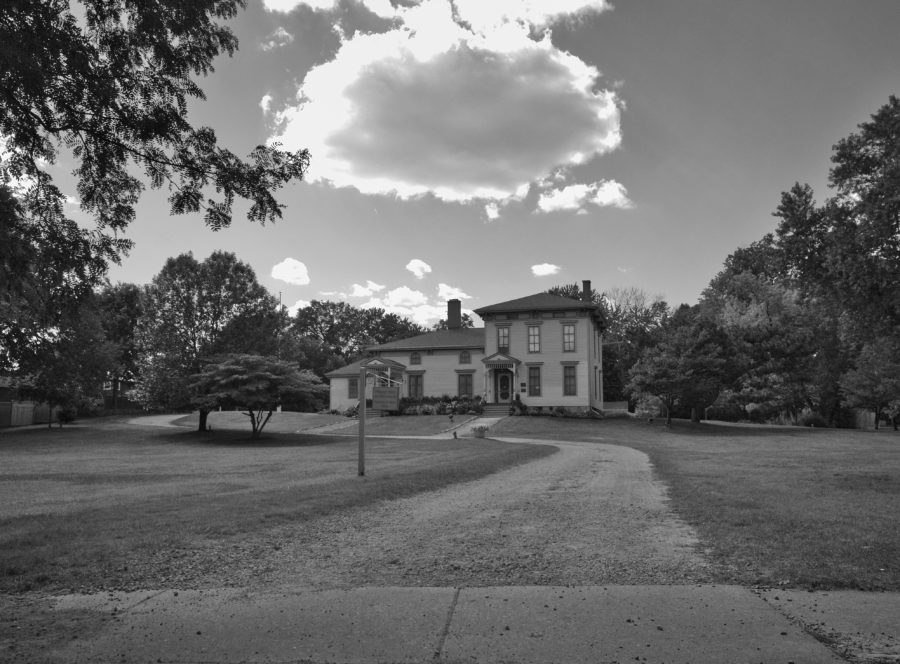
Noble-Seymour-Crippen House and driveway, seen from Newark Avenue. [Gabriel X. Michael/Chicago Patterns]
The Noble-Seymour-Crippen House was designated a City of Chicago Historical Landmark on May 11, 1988 and listed on the National Register of Historic Places on August 11, 2000. It remains the home of the Norwood Park Historical Society and sits on an expansive lot with a winding driveway to the house, reminiscent of its days as a homestead house.

John Wingert House, built 1854 (2-story Italianate addition circa 1868 – 1875), 6231 North Canfield Avenue. [Gabriel X. Michael/Chicago Patterns]
Another of Chicago’s oldest known houses is to the northwest, near the intersection of Canfield Road and Talcott Avenue, the John Wingert House. Like the Noble-Seymour-Crippen house, it began as a single-story frame farmhouse and a 2-story Italianate addition was built around 1870. Unlike the Noble-Seymour-Crippen House though, this home was not cared for or maintained well. Throughout the late 20th Century the house fell into a state of disrepair and neglect, as described by former neighbors who grew up nearby:
As described by architecture critic Blair Kamin in a Chicago Tribune article, things came to a head in 1990 ultimately, and the situation had deteriorated so greatly that the house was threatened with demolition, but was fortunately given a reprieve by the Landmarks Commission.
On July 30th of that year, its protection and preservation was ensured when it was designated as a Chicago Landmark. According to the Chicago Landmarks site:
“This modest building is one of the few surviving early farmhouses located within the Chicago city limits. It was built as the residence of John Wingert, one of a number of immigrants who, in seeking refuge from religious persecution in Germany, created a settlement called Canfield on the prairie frontier.”
It is interesting to note that Canfield Avenue serves as the boundary between Park Ridge (on the left side of the below image) and Chicago (on the right side). This area of Norwood Park (locally known as Norwood Park West) was not annexed until after 1921, when suburban resistance among other factors virtually halted any further growth of the City of Chicago.
In the rest of this article, we’ll look at 25 other very old and significant houses throughout Old Norwood Park by decade, with basic observations about each house as well as any historic information discovered and building documentation in the Chicago Landmarks Historic Resources Survey (if included).
More Historic Houses of Old Norwood Park
Built 1840s – 1860s
Martin Stevens House, 6804 West Hurlbut Street (misidentified in city records as “6804 North Newcastle Avenue”), built 1860s or earlier. Orange-Rated in the Chicago Historic Resources Survey.
This uncommon vernacular example of Second Empire architecture is dominated by a central tower with concave roof and window dormers on all four sides. Looking closer, the tops of the windows echo the form of the tower itself. Other style elements are the straight-lined mansard roof with multiple dormers and paired windows.
“My mom grew up a few blocks away and always heard stories it was ‘pre-Fire’. People supposedly watched the city burn from its tower.” -Rachel Freundt
The rear northwest corner of the house (not pictured) features an octagonal tower, which calls to mind the fascinating trend of “octagon houses” of the 1850s and 1860s. The former owner and namesake of the house, Martin Stevens, was a prominent Norwood Park Village Trustee in the 1870s.
Allison Abbott House, 5732 North New Hampshire Avenue, built 1841. Yellow-Rated in the Chicago Historic Resources Survey.
The steep slope of the 4-sided gable roof and symmetrical form are clues to the age and style of this two-story former farmhouse. It is described accurately in the CHRS as a classical “homestead house” but erected in the 1880s, which seems incorrect.
Although it may not garner instant attention like other fancifully painted Victorians in the neighborhood, there is an intriguing story behind this handsome 175-year-old house, according to current owner Curtis Cornwell:
“Allison Abbott purchased 79.72 acres for $99.94 in 1841 and built the house originally located at the corner of [West] Ardmore and [North] New Hampshire [Avenues]. The house was built as a simple farmhouse with square nails and hand-hewn boards.”
“In 1908, the house was moved using a team of horses from Southern Illinois, pulling it over logs to the present location. The house fell into disrepair in the late 1960s, when the previous owner bought the home and painstakingly restored it and later added onto the home.”
![Scene at a neighborhood block party outside 5732 North New Hampshire Avenue [Ben Frank]](http://chicagopatterns.com/wp-content/uploads/2016/09/5732-768x1024.jpeg)
Scene at a neighborhood block party outside the house at 5732 North New Hampshire Avenue. [Ben Frank]
Curtis also described the original and unique features defining his family’s home, including exquisite diamond shaped windows that were salvaged from a Wisconsin Methodist church and installed in the southern two-story “wing”-like addition:
“The home features many of the original features including the wood floors and stained glass. Despite the age of the house, we are only the sixth family to have lived here.”
![A commemorative plate from the Wisconsin church where diamond windows were salvaged for 5732 North New Hampshire Avenue [courtesy of Curtis Cornwell]](http://chicagopatterns.com/wp-content/uploads/2016/10/Church-Plate-751x900.jpg)
A commemorative plate from the Wisconsin church where diamond windows were salvaged for 5732 North New Hampshire Avenue. [courtesy of Curtis Cornwell]

[Gabriel X. Michael/Chicago Patterns]
Original features like the double bracketing and carved wooden hood surrounding the second-story paired window are classic Italianate elements. The bold use of teal detailing on eaves, stairs, and side fence is pleasing to see. Simple spindle and fretwork accent the front porch, and the front door appears to be a replacement, while the overhead transom still remains.

[Gabriel X. Michael/Chicago Patterns]
5837 North Nicolet Avenue, built 1860s. Orange-Rated in the Chicago Historic Resources Survey.
This house appears to be a former farmhouse on a large lot—the broad front facade, cross-gable roof, and classical facade give clues to its age and original purpose.
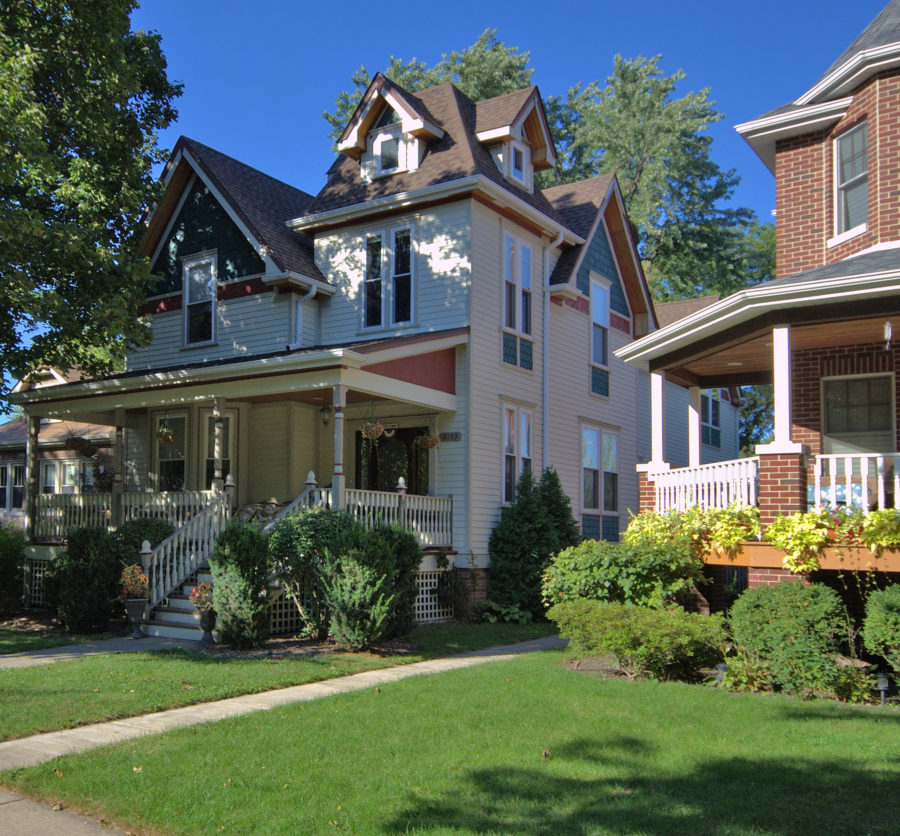
[Gabriel X. Michael/Chicago Patterns]
6153 North Northcott Avenue, built 1860s. Orange-Rated in the Chicago Historic Resources Survey.
This gorgeous house features an interesting color scheme, multiple cross gables, plus paired windows and an off-center dormered tower similar to the Martin Stevens House, a possible Second Empire-inspired architectural element from its reported 1860s build date.
Russell Morton House, 6010 North Nickerson Avenue, built 1867. Orange-Rated in the Chicago Historic Resources Survey.
Excellent example of Italianate style applied to a former farmhouse, featuring arched “bifiora” or paired windows on both levels and a steeply-pitched cross-gable roof. This house would have been built right around the time Circle Avenue and other inspired development was taking shape.
David Woodard House, 7130 West Talcott Avenue, built 1860s or earlier. Orange-Rated in the Chicago Historic Resources Survey.
The CHRS classifies this former farmhouse as “Italianate” in architectural style, but any identifiable sign of this is missing in its current state or obscured by apparent additions. Other aspects like the extra-large lot this house is set back on provide context clues to its history.
Built 1870s
6824 West Ardmore Avenue, built 1870s. Orange-Rated in the Chicago Historic Resources Survey.Classic Italianate styling with double bracketing, window molds, and bright blue paneling surrounding the eaves, and large porch with carport addition.
5929 North East Circle Avenue, built 1870. Orange-Rated in the Chicago Historic Resources Survey.
Details like the original rounded moldings with keystones that surround the front door and windows, a veranda-like wraparound porch, plus the tall, narrow shape of the house express the Italianate style. The fishscale shinglework filling within the eave area looks like a more recent addition. The medium blue primary exterior color with cream colored accents is tasteful and elegant.
5971 North Nina Avenue, built 1870. Orange-Rated in the Chicago Historic Resources Survey.
Some historic details remain on this house, specifically the intricate moldings surrounding the door and top-level double window (like 5929 North East Circle Avenue discussed above), and the oval window on the south elevation. Modern fishscale shingles adorn the eave area on this house as well.
Lukas House, 5910 North East Circle Avenue, and 5914 North East Circle Avenue, built 1870s. Both are Orange-Rated in the Chicago Historic Resources Survey.
The house on the left at 5910 features traditional Italianate fenestration or window layout with carved hoods, an original paired front door with decorative carvings, and a two-story bay tower that may have been a later addition. The light blue house at 5914 looks similar to the Russell Morton House, with a rounded arch-shape paired window on the top level, cross gables and a steep roof line.
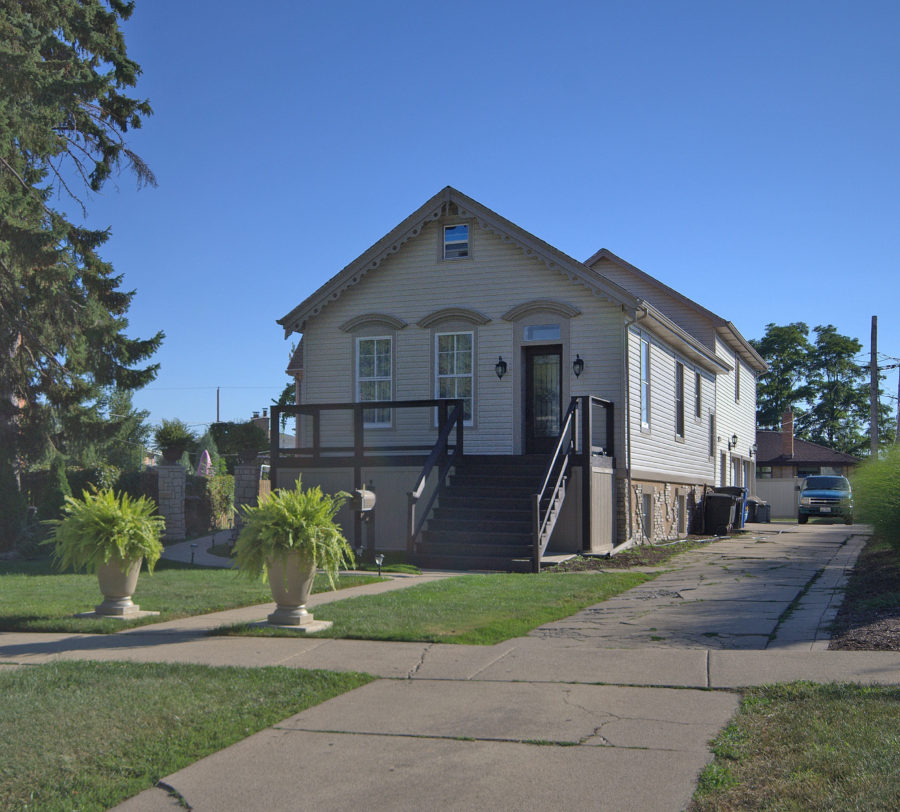
[Gabriel X. Michael/Chicago Patterns]
Worker’s Cottage, 6865 West Hobart Avenue, built 1870s. Orange-Rated in the Historic Resources Survey.
This could be the only intact Worker’s Cottage-style house remaining in Old Norwood Park, based on my personal survey. Though many changes have been made, like a large rear addition that includes a garage, period appropriate details like the decorative bargeboard trim, tiny attic space window, elongated front windows with carved rounded hoods, and front door transom window are present.
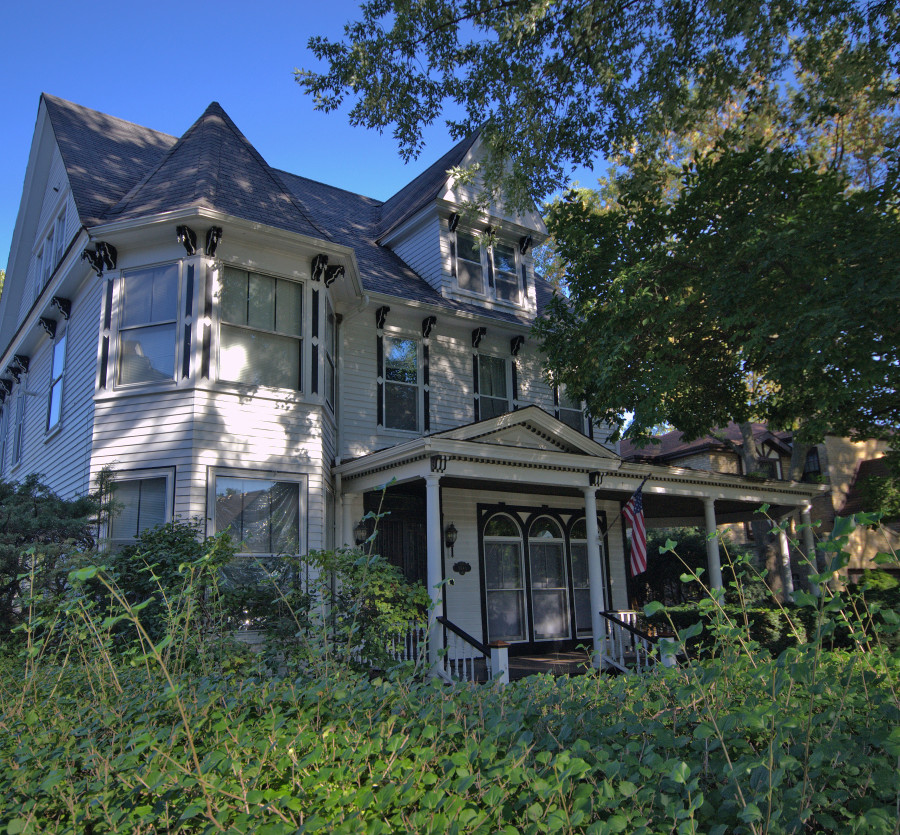
[Gabriel X. Michael/Chicago Patterns]
Winchell House, 5943 North East Circle Avenue, built 1870s. Orange-Rated in the Historic Resources Survey.
This large home features an eclectic mix of Victorian elements: small black and white bracketing around all eaves, a side bay tower, wraparound front porch, and trio of double-hung arched windows.
6070 North Northcott Avenue, built 1870s. Orange-Rated in the Historic Resources Survey.
Impressive spindlework and fret-sawn panels reminiscent of 1880s Stick Style architecture makes the front porch the defining characteristic of this house.
5959 North Nina Avenue, built 1870s. Orange-Rated in the Historic Resources Survey.
The long and narrow front windows and paired front door with transom illustrate the age of this house, although it has received several modifications from its original form, possibly including the wide two-story tower-like part on the north side (left in image).
Built 1880s and later
5835 North East Circle Avenue, built 1890s. Orange-Rated in the Historic Resources Survey.
This beautiful house is defined by its large gables and a huge off-center tower with a small front porch at the base featuring fan-like spindlework. Diagonal siding within the gables forms a contrasting pattern to the horizontal wall siding.
6814 West Ardmore Avenue, built 1890. Not listed in the Chicago Historic Resources Survey.
The porch wrapping around this Queen Anne Shingle Style-inspired house flaunts unique spindlework, and the off-center two-story bay tower is the central dominating architectural element.
New construction at 5943 North Nina Avenue has a strong “quasi-historic” Italianate style, and replaced this 1870 frame house that previously occupied the site. The neighboring house to the north (5945 North Nina Avenue) appears to have multiple additions or was intentionally designed that way. The gable furthest back is paired with a Queen Anne-style corner tower, but this house has a reported 1954 build date so this could also be more recent and “quasi-historic” in style.
Homes at North Newcastle and West Hurlbut Avenues: 5707 (left, built 1931) and 5701 (right, built 1929). 5701 recently suffered a devastating fire, which was captured on video and can be seen below:
However, as seen in the top photo, the owners have recovered and repaired the house beautifully. The bell-shaped roof with dormers on both sides is a Dutch Colonial Revival architectural feature, and the contrasting green roof and golden exterior is striking. It was designed by Charles F. Wheeler and is Yellow-Rated in the CHRS.
6202 North Neva Avenue, built 1890s. Orange-Rated in the Historic Resources Survey.
Sitting on a corner lot at Neva and Myrtle Avenues, the second-story corner bay tower catches the eye immediately. Upon closer look, there is lovely fishscale shinglework covering the second story walls, along with the complementing purple and dark turquoise accent colors around windows.
Built near the turn of the 20th Century, this simple house features sunburst-style decorative trussing at the top of the gable and surrounding the small front porch.
6072 North Nickerson Avenue (Norwood Park Methodist Episcopal Church, also addressed as 7110 West Hood Avenue), built 1894-1895. Orange-Rated in the Chicago Historic Resources Survey.
With its steep tower and cross gables, and tripartite pointed arch windows on all sides, the Gothic Revival influence can definitely be seen in this wood-frame church. Built in 1894, this is the oldest remaining church building in Norwood Park, and was originally built for the Norwood Park Methodist Episcopal Congregation.
From the New Hope United Methodist Church website:
Do you have any interesting connections or history about these buildings, or special memories of long-lost historic houses in the neighborhood? Please share your story and feedback in the comments below and in Chicago Architecture Data’s Old Norwood Park comprehensive building database. Old Norwood Park is one of the best examples of a historic urban neighborhood preserving its roots, and so rich in history and beautiful old architecture that a “Part Two” to this story can never be ruled out!“Our church building was originally erected for the congregation of Norwood Park Methodist Episcopal Church, founded on August 20, 1894. The cornerstone for the church building was laid on Thanksgiving Day, 1894 and the building was dedicated on July 7, 1895. It is the oldest surviving church structure in Norwood Park.”
References / Further Reading:
- “Norwood Park”, Encyclopedia of Chicago
- Norwood Park Historical Society
- Old Norwood Park neighborhood, Chicago Architecture Data
- City of Chicago-Chicago Landmarks search page

![Homes in the 5700 block of North East Circle Avenue [Gabriel X. Michael/Chicago Patterns]](http://chicagopatterns.com/wp-content/uploads/2016/10/DSC_0656-900x703.jpg)


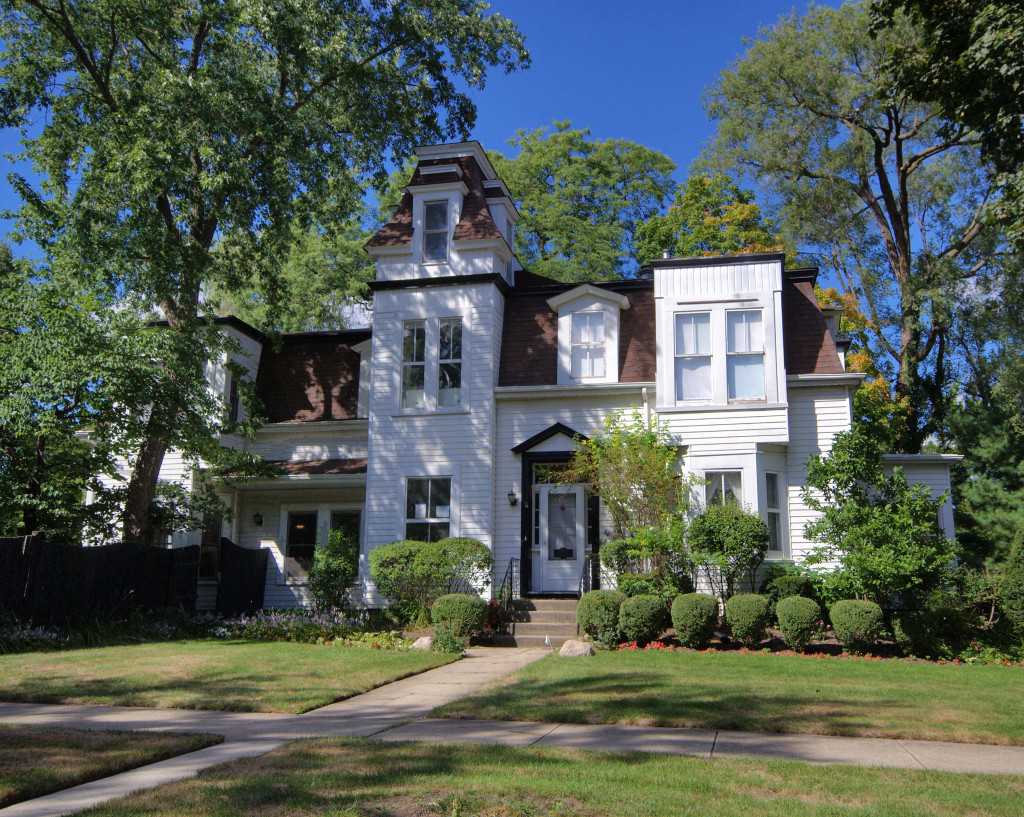


![Image of the original house prior to more recent additions, date unknown [Photographer unknown]](http://chicagopatterns.com/wp-content/uploads/2016/09/Original-House-900x629.jpg)


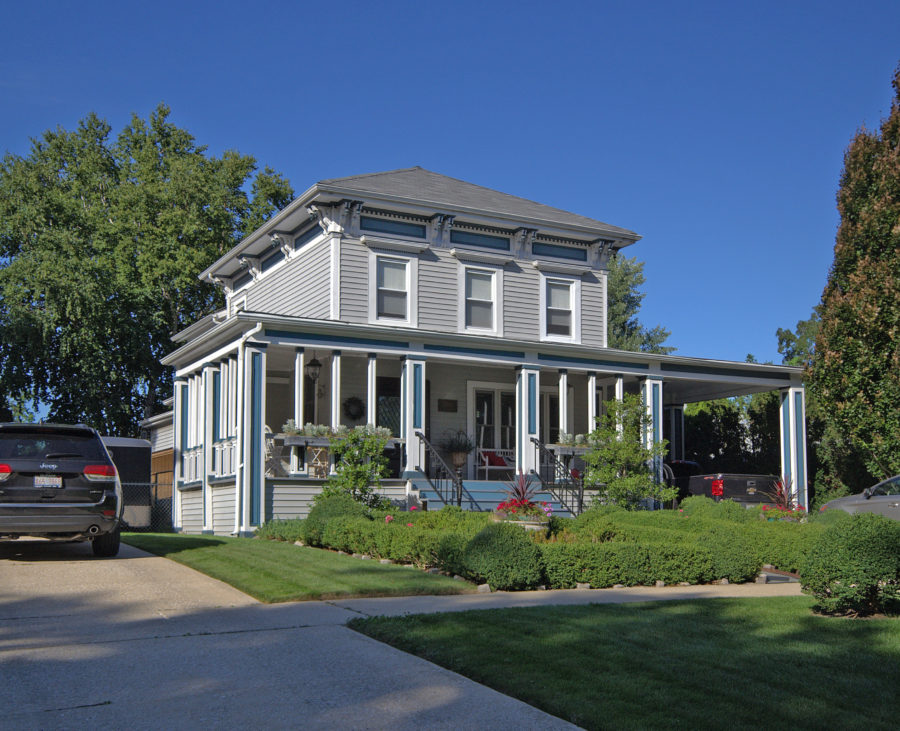
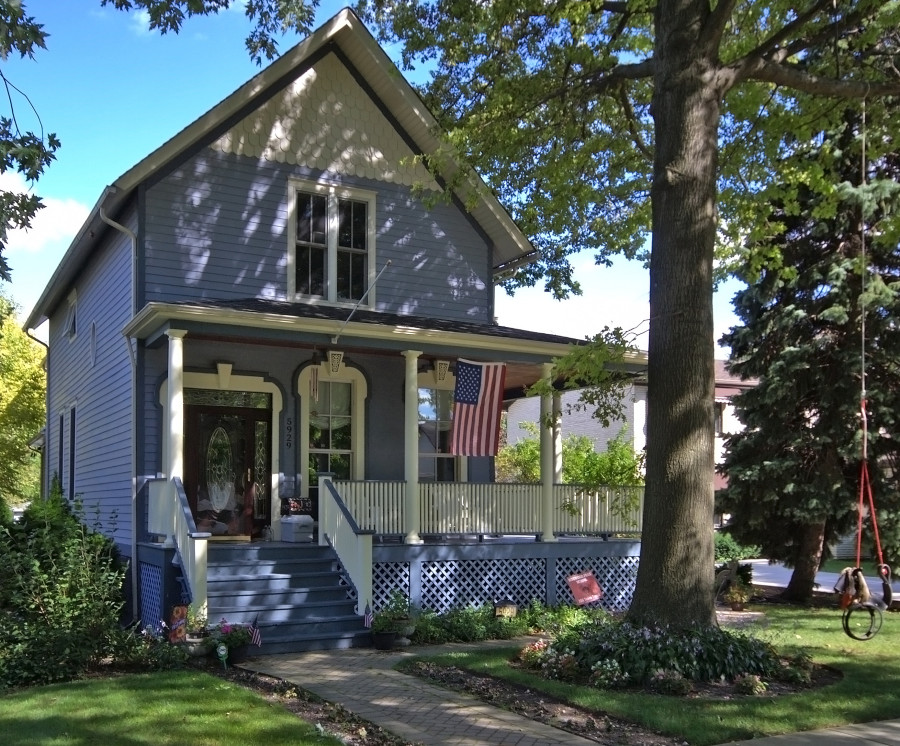
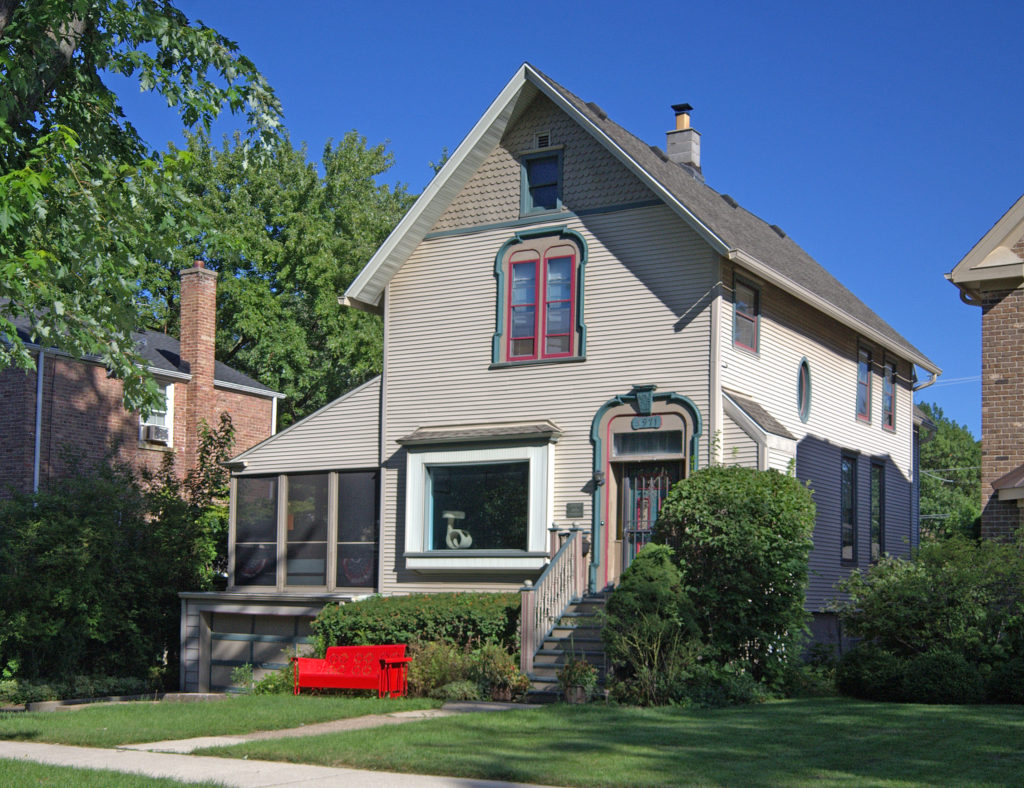
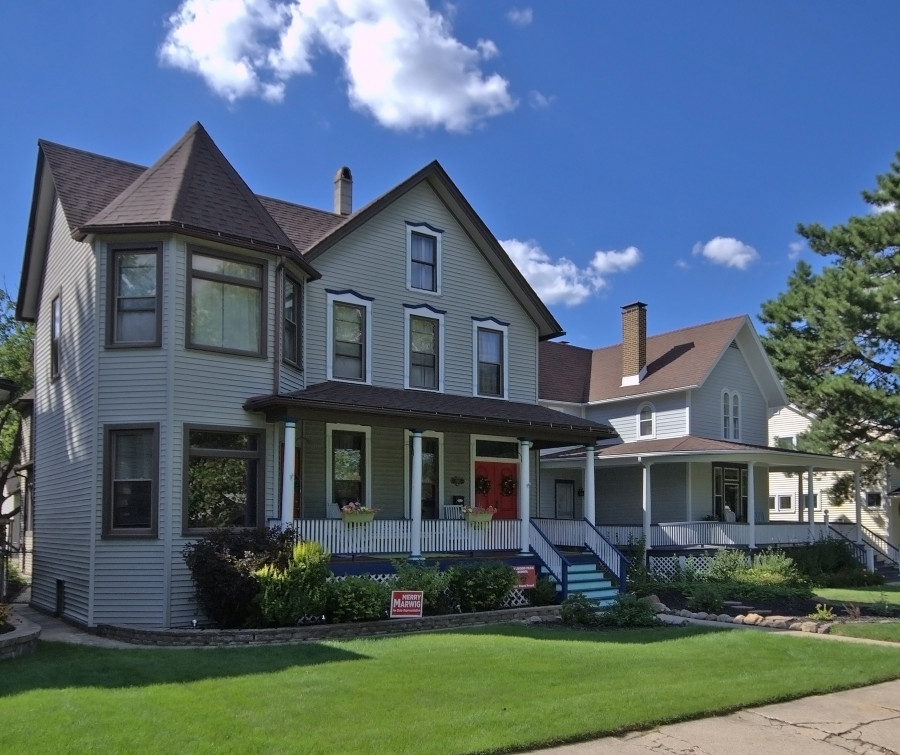
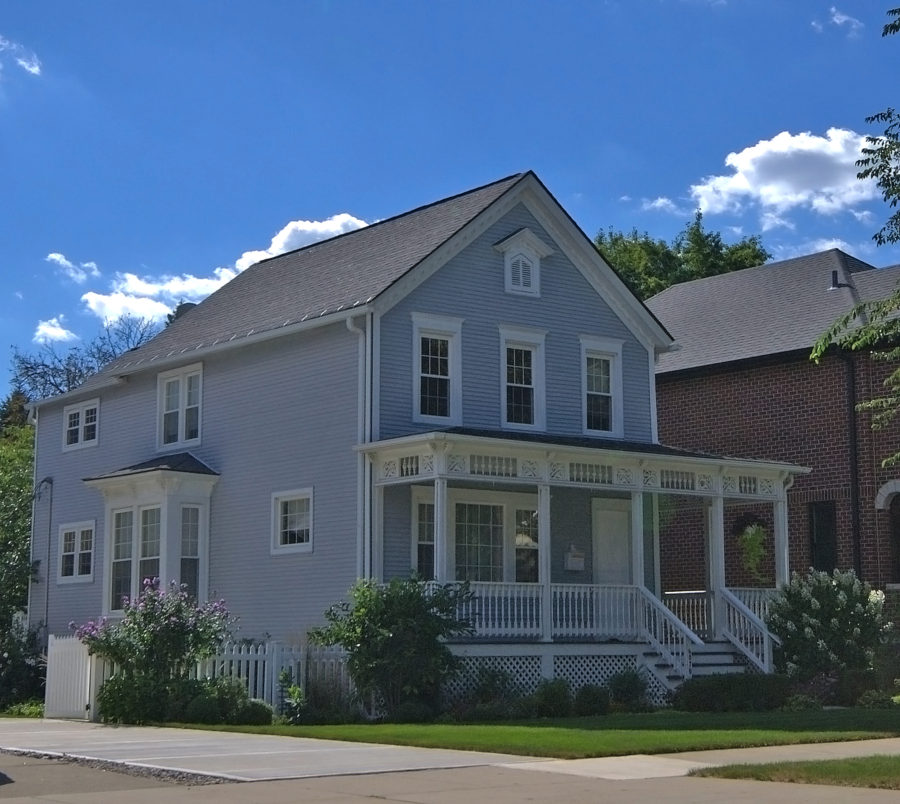
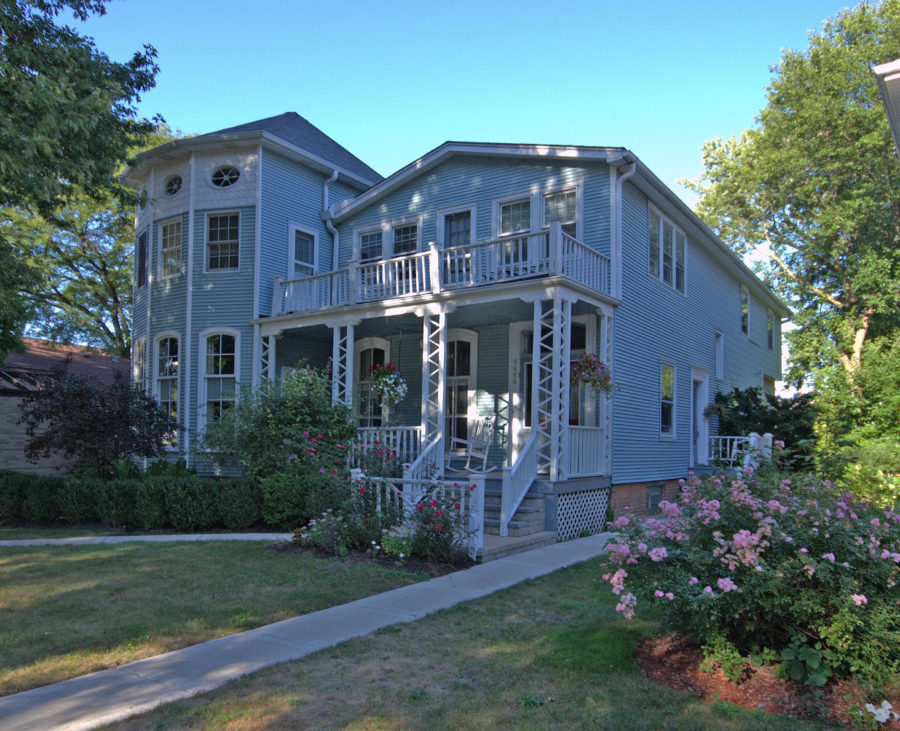
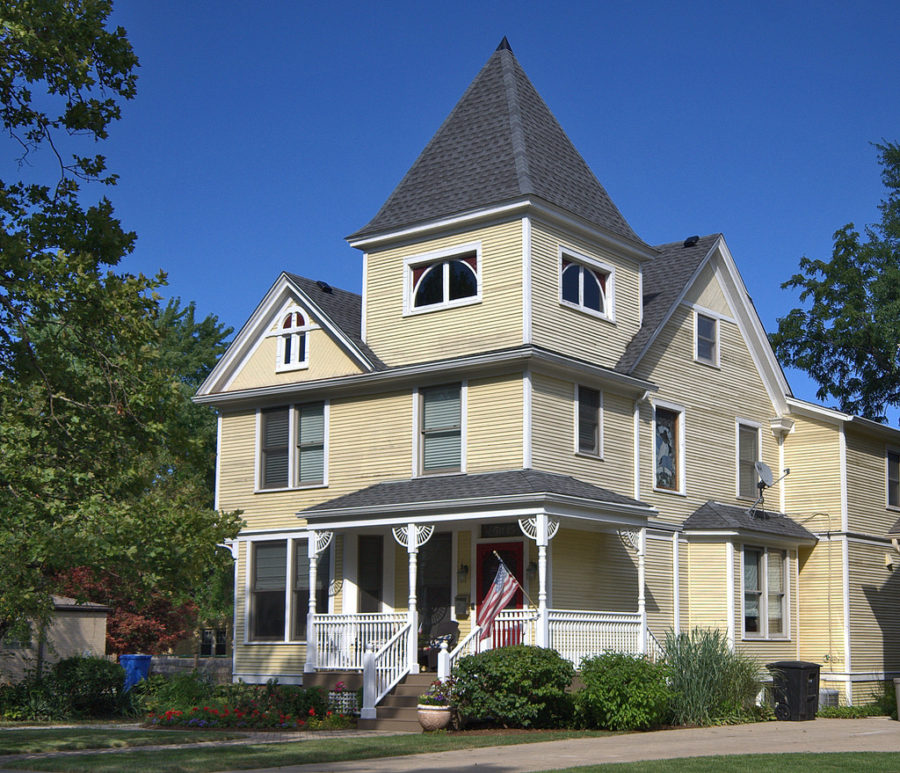

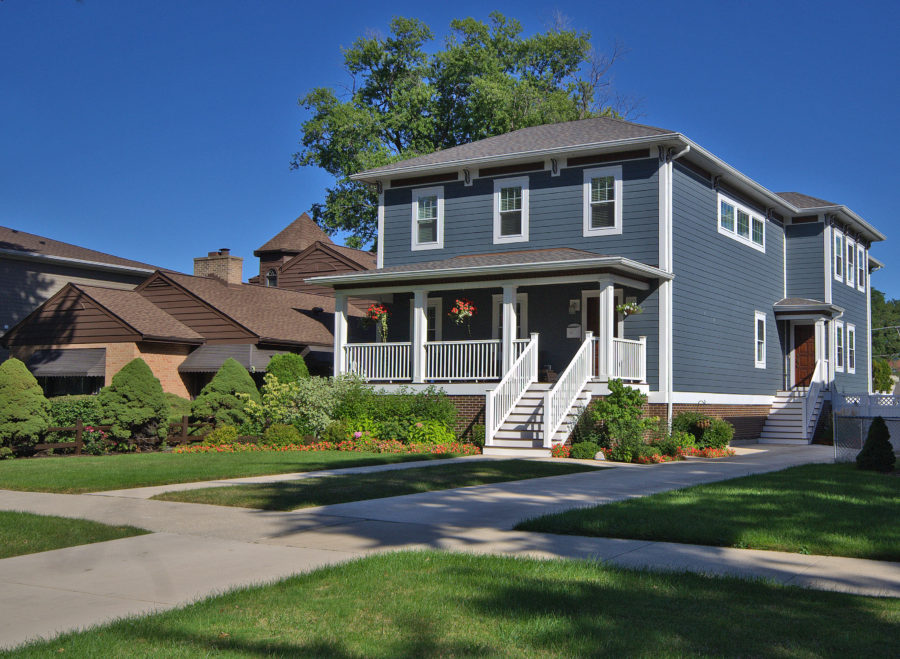

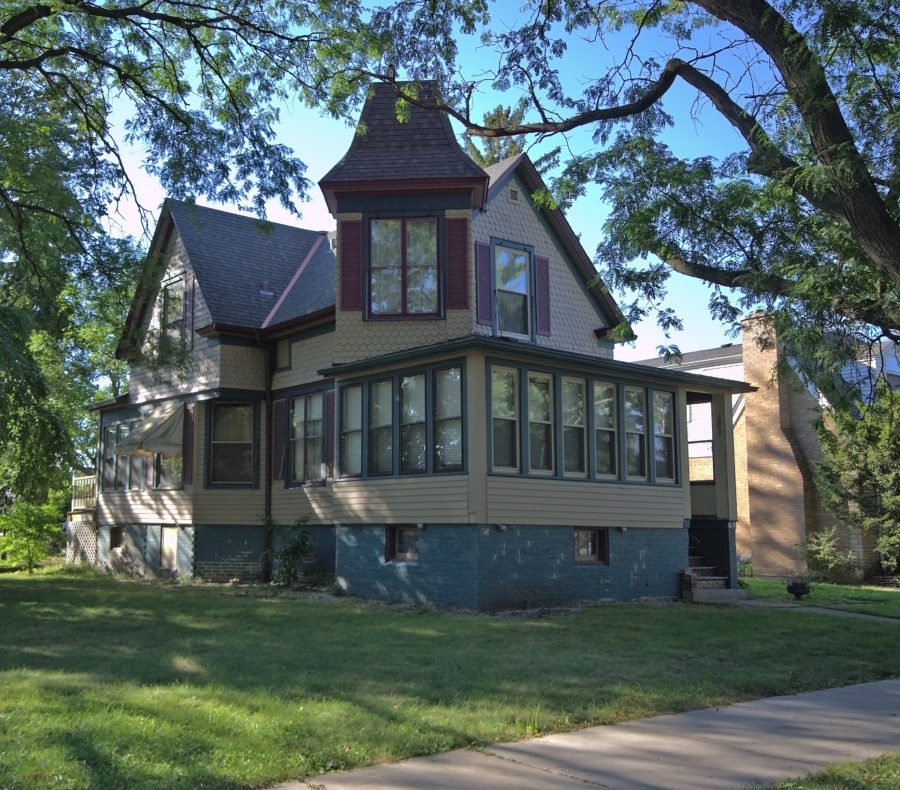
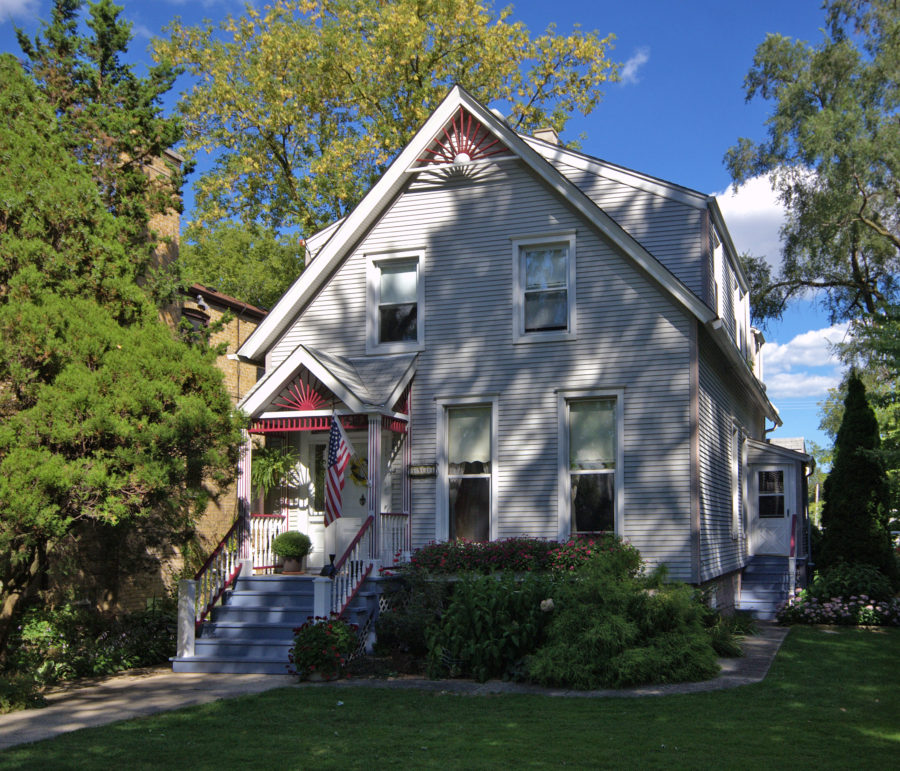
![[Gabriel X. Michael/Chicago Patterns]](http://chicagopatterns.com/wp-content/uploads/2016/09/DSC_0335-900x800.jpg)
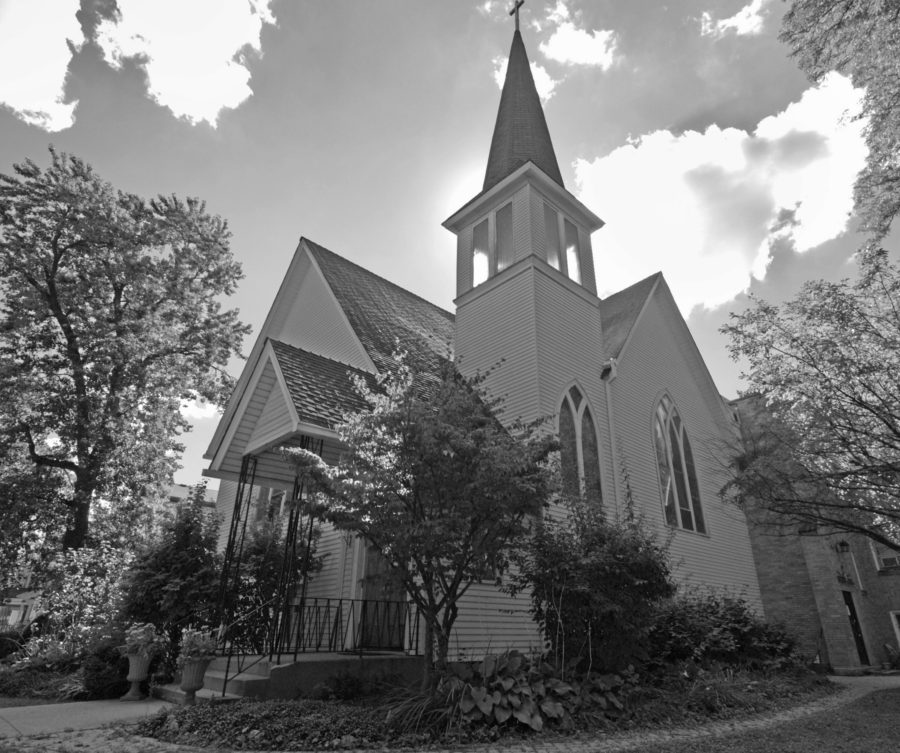

Another really great article, Gabriel. So informative! Congratulations!
6041 N Nickerson is a new house. The home photographed replaced the 1885 structure. The Noble-Seymour-Crippen House, home of the Norwood Park Historical Society, is open envy Saturday from noon to 4:00pm.
Susan, thank you very much for the information! We’ve made an update to exclude it from that part of the article.
Gabriel, I want to personally thank you for this post. Looking at these old homes, looking at all the history within them, it just makes me so emotional.
Preserving those beautiful pictures of history, is extremely important. Not only did you provide us with wonderful pictures of these homes/buildings but also you gave very insightful information for each.
Thank you for sharing and well done!
Wow- beautiful homes and very informative! Such an enjoyable read, great article!!
Thank you for this wonderful article. We lived at 5732 N.New Hampshire from spring 1979 to October 2013. Handing the keys over to a family that loves it (and Norwood Park) like we did, makes the change easier. Again, thank you!
Lovely article. The home you identified as 5958 Nina is actually on East Circle. John and Diane Fallon live there. I am at 5909 N East Circle. The home on West Ardmore with the wrap around porch has quite a history. The Eshoo’s live there and say that Buck lived there.
Hi. I was wondering if someone could help me with the address of the house in this article I’ve linked. My Great Grandfather was the original owner and I just found the article and my father wanted to write the current owners. I appreciate any help you could give.
http://www.chicagomag.com/Radar/Deal-Estate/January-2008/Sale-of-the-WeekaChicagoas-Old-Norwood/
Thank you,
Tiffany Peckham D’Andrea
Tiffany.dandrea@gmail.com
I would try first contacting the real estate person who sold the house in this article. they might be able to pass on the info to the owners to contact you. another option is google street view…..stroll down the streets till you find the house, then use the address and search the sales/tax info from the court house to find current owners. good luck!
The pictures house is on the 5800 block of East Circle. Anne Lunde or the Norwood Park Historical Society May have the home’s history
When was 5960 North Neva Ave built?